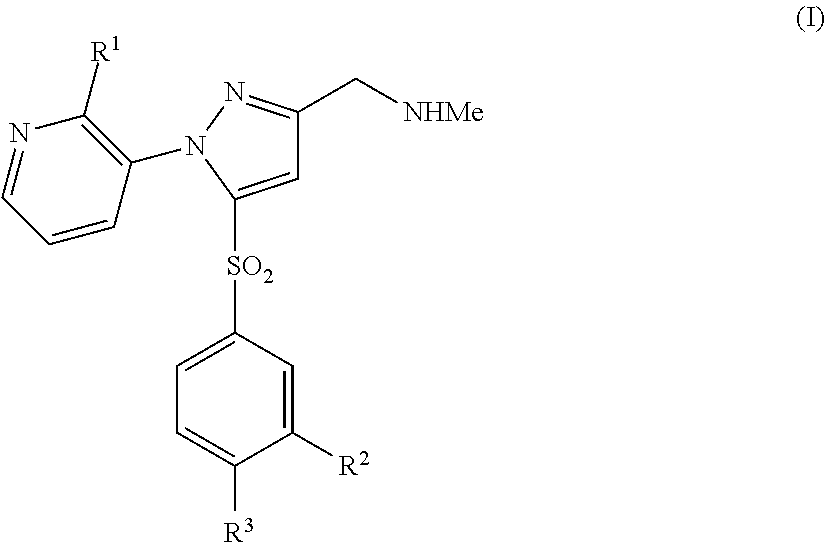Pyrazole compound
a compound and pyrazole technology, applied in the field of pyrazole compound, can solve the problems of side effects and effects of proton pump inhibitors, and achieve the effects of suppressing acid secretion, superior proton pump inhibitory effect, and inhibiting enzyme activity
- Summary
- Abstract
- Description
- Claims
- Application Information
AI Technical Summary
Benefits of technology
Problems solved by technology
Method used
Image
Examples
reference example 1
ethyl 1-(2-fluoropyridin-3-yl)-5-hydroxy-1H-pyrazole-3-carboxylate
[0125]
[0126]To a solution of 2-fluoro-3-hydrazinopyridine (30.0 g) in ethanol (472 mL) were added sodium carbonate (65.2 g) and diethyl but-2-ynedioate (40.2 g). After refluxing for 18 hr, the mixture was cooled to room temperature, treated with 2 mol / L hydrochloric acid, and extracted twice with ethyl acetate. The extract was dried over anhydrous sodium sulfate and concentrated under reduced pressure. The residue was suspended in diethyl ether, and the obtained solid was collected by filtration and dried under reduced pressure to give the title compound as a yellow solid (yield 20.0 g, yield 34%).
[0127]1H-NMR (DMSO-d6) δ: 1.28 (3H, t, J=7.2 Hz), 4.23 (2H, q, J=7.2 Hz), 5.94 (1H, s), 7.57 (1H, ddd, J=7.6, 4.8, 1.2 Hz), 7.49 (1H, ddd, J=9.6, 7.6, 1.6 Hz), 8.39 (1H, dt, J=4.8, 1.6 Hz), 12.3 (1H, brs).
reference example 2
ethyl 1-(2-fluoropyridin-3-yl)-5-{[(trifluoromethyl)sulfonyl]oxy}-1H-pyrazole-3-carboxylate
[0128]
[0129]To a solution of ethyl 1-(2-fluoropyridin-3-yl)-5-hydroxy-1H-pyrazole-3-carboxylate (2.0 g) in tetrahydrofuran (20 mL) were added triethylamine (966 mg) and N-phenylbis(trifluoromethanesulfonimide) (3.1 g). After stirring at room temperature for 15 min, water was added to the reaction mixture, and the mixture was extracted with ethyl acetate. The extract was washed with saturated brine, dried over anhydrous sodium sulfate, and concentrated under reduced pressure. The residue was purified by silica gel column chromatography (eluent: hexane-ethyl acetate=19:1→9:1) to give the title compound as a yellow oil (yield 2.1 g, yield 70%).
[0130]1H-NMR CDCl3) δ: 1.43 (3H, t, J=7.2 Hz), 4.46 (2H, q, J=7.2 Hz), 6.88 (1H, s), 7.40-7.45 (1H, m), 7.99-8.06 (1H, m), 8.40-8.43 (1H, m).
reference example 3
ethyl 5-[(4-fluorophenyl)sulfanyl]-1-(2-fluoropyridin-3-yl)-1H-pyrazole-3-carboxylate
[0131]
[0132]A solution of ethyl 1-(2-fluoropyridin-3-yl)-5-{[(trifluoromethyl)sulfonyl]oxy}-1H-pyrazole-3-carboxylate (353 mg), 4-fluorobenzenethiol (130 mg) and sodium carbonate (146 mg) in toluene (5 mL) was sufficiently deaerated. Tris(dibenzylideneacetone)dipalladium(0) (8.4 mg) and 4,5-bis(diphenylphosphino)-9,9-dimethylxanthene (11 mg) were added and the mixture was further deaerated. The mixture was stirred under an argon atmosphere at 110° C. for 3 hr, allowed to cool to room temperature, ethyl acetate was added, and the mixture was filtered through a silica gel pad. The organic layer of the filtrate was washed with saturated brine, dried over anhydrous sodium sulfate, and concentrated under reduced pressure. The residue was silica gel column chromatography (eluent: hexane-ethyl acetate=19:1→2:1) to give the title compound as a crude yellow oil (yield 203 mg).
PUM
| Property | Measurement | Unit |
|---|---|---|
| reaction temperature | aaaaa | aaaaa |
| reaction temperature | aaaaa | aaaaa |
| acid secretion | aaaaa | aaaaa |
Abstract
Description
Claims
Application Information
 Login to View More
Login to View More - R&D
- Intellectual Property
- Life Sciences
- Materials
- Tech Scout
- Unparalleled Data Quality
- Higher Quality Content
- 60% Fewer Hallucinations
Browse by: Latest US Patents, China's latest patents, Technical Efficacy Thesaurus, Application Domain, Technology Topic, Popular Technical Reports.
© 2025 PatSnap. All rights reserved.Legal|Privacy policy|Modern Slavery Act Transparency Statement|Sitemap|About US| Contact US: help@patsnap.com



